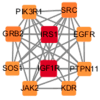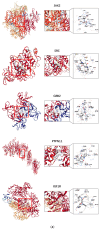Investigating the Potential Effects of 6PPDQ on Prostate Cancer Through Network Toxicology and Molecular Docking
- PMID: 39771106
- PMCID: PMC11728691
- DOI: 10.3390/toxics12120891
Investigating the Potential Effects of 6PPDQ on Prostate Cancer Through Network Toxicology and Molecular Docking
Abstract
(1) Background: N-(1,3-Dimethylbutyl)-N'-phenyl-p-phenylenediamine-quinone (6PPDQ), as a newly discovered environmental toxin, has been found more frequently in our living conditions. The literature reports that damage to the reproductive and cardiovascular system is associated with exposure to 6PPDQ. However, the relationship between 6PPDQ and cancer still requires more investigation. This research aims to investigate the association between 6PPDQ and prostate cancer. (2) Methods and Results: Based on the data retrieved from the Pharmmapper, CTD, SEA, SwissTargetPrediction, GeneCard, and OMIM databases, we summarized 239 potential targets utilizing the Venn tool. Through the STRING network database and Cytoscape software, we constructed a PPI network and confirmed ten core targets, including IGF1R, PIK3R1, PTPN11, EGFR, SRC, GRB2, JAK2, SOS1, KDR, and IRS1. We identified the potential pathways through which 6PPDQ acts on these core targets using Gene Ontology (GO) and Kyoto Encyclopedia of Genes and Genomes (KEGG) analyses. Ultimately, through molecular docking methods, 6PPDQ binds closely with these ten core targets. These findings indicate that 6PPDQ may influence the proteins related to prostate cancer and may be linked to prostate cancer via several known signaling pathways. (3) Conclusions: This article employs innovative network toxicology to elucidate the prostate carcinogenic effects of 6PPDQ through its modulation of specific vital genes and signaling pathways, thereby establishing a foundational platform for future investigations into the impact of 6PPDQ on prostate cancer and potentially other tumors.
Keywords: 6PPDQ; molecular docking; network toxicology; prostate cancer.
Conflict of interest statement
The authors declare that they have no competing interests, whether they are financial, personal, or professional.
Figures









Similar articles
-
Research on the Regulatory Mechanism of Ginseng on the Tumor Microenvironment of Colorectal Cancer based on Network Pharmacology and Bioinformatics Validation.Curr Comput Aided Drug Des. 2024;20(5):486-500. doi: 10.2174/1573409919666230607103721. Curr Comput Aided Drug Des. 2024. PMID: 37287284
-
Exploring the therapeutic mechanism of curcumin in prostate cancer using network pharmacology and molecular docking.Heliyon. 2024 Jun 19;10(12):e33103. doi: 10.1016/j.heliyon.2024.e33103. eCollection 2024 Jun 30. Heliyon. 2024. PMID: 39022084 Free PMC article.
-
An integrative analysis reveals cancer risk associated with artificial sweeteners.J Transl Med. 2025 Jan 8;23(1):32. doi: 10.1186/s12967-024-06047-0. J Transl Med. 2025. PMID: 39780215 Free PMC article.
-
Exploring active ingredients and mechanisms of Coptidis Rhizoma-ginger against colon cancer using network pharmacology and molecular docking.Technol Health Care. 2024;32(S1):523-542. doi: 10.3233/THC-248046. Technol Health Care. 2024. PMID: 38759074 Free PMC article.
-
Network toxicological and molecular docking to investigate the mechanisms of toxicity of agricultural chemical Thiabendazole.Chemosphere. 2024 Sep;363:142711. doi: 10.1016/j.chemosphere.2024.142711. Epub 2024 Jul 2. Chemosphere. 2024. PMID: 38964723
References
-
- Seiwert B., Nihemaiti M., Troussier M., Weyrauch S., Reemtsma T. Abiotic oxidative transformation of 6-PPD and 6-PPD quinone from tires and occurrence of their products in snow from urban roads and in municipal wastewater. Water Res. 2022;212:118122. doi: 10.1016/j.watres.2022.118122. - DOI - PubMed
Grants and funding
LinkOut - more resources
Full Text Sources
Research Materials
Miscellaneous

